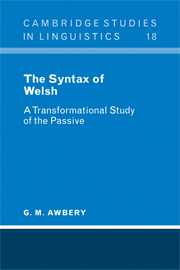6 - A DEEP STRUCTURE AGENT PHRASE?
Published online by Cambridge University Press: 04 August 2010
Summary
It has been assumed throughout this study that the agent phrase of the passive should be derived by a postposing rule, which was formulated in Chapter 2 as T. Agent Postposing. Difficulties arose however in the last chapter in trying to give independent motivation to this rule, and there is in fact some evidence that the whole approach is mistaken. It is possible that the agent phrase is already present in sentence-final position in deep structure, not postposed into this position in the course of the derivation. This alternative analysis is now explored. In section 6.1 certain constructions containing the verb cael and the preposition gan will be examined and it will be argued that the prepositional phrase should be present in deep structure. In section 6.2 the cael passive will be compared with these forms and the possibility discussed that the prepositional phrase in this case too should be present in deep structure.
Constructions with cael and gan
Lexical objectCael may appear as the verb of a simple sentence with a lexical noun or a pronoun as direct object. Here it has the meaning ‘receive’. The subject is the recipient, the object the thing received and the object of the preposition gan is the source.
(1) Cafodd Wyn anrheg gan ei frawd.
Got Wyn (a) present by his brother.
i.e. Wyn got a present from his brother.
- Type
- Chapter
- Information
- The Syntax of WelshA Transformational Study of the Passive, pp. 200 - 218Publisher: Cambridge University PressPrint publication year: 1977



